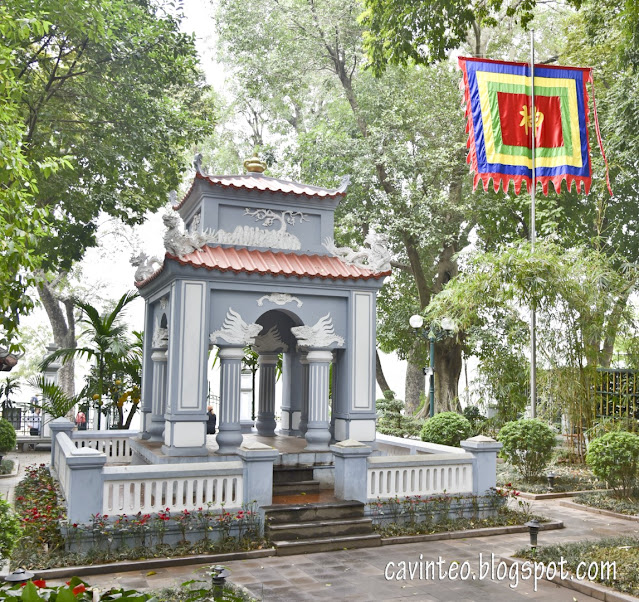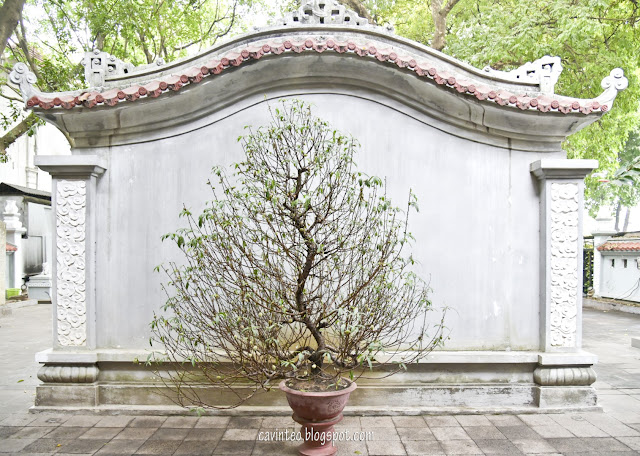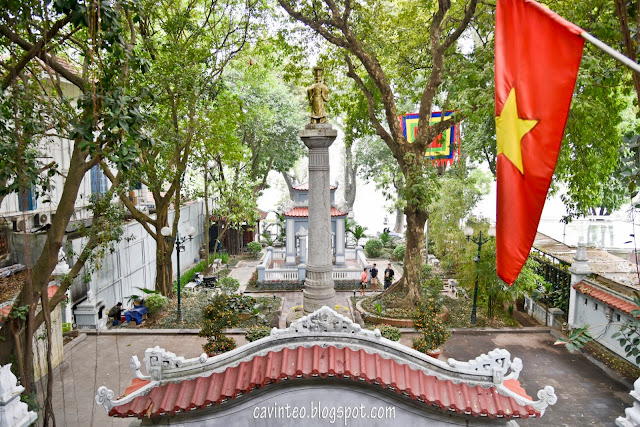There were actually two different sections within the same compound and I was confused when I was searching for the correct names while generating the itinerary post for Hanoi; so, they would be King Le Thai To Monument and Nam Huong Communal House.
King Le Thai To Monument would be the first section to greet you should you enter from the side of Hoan Kiem Lake, although I have no idea what this structure was for since there's nothing on display.
I was way more captivated by the large oranges on this plant.
According to the stone plaque, this monument was established in 1896 to commemorate King Le Thai To, a man of many legends. The most famous one contributed to a change of name for a lake; yes, Hoan Kiem Lake, which means the lake of the returned sword.
See! It's more like a pretty pavilion where we can shield from the rain!
My guess is that this would be the correct monument; it had a statue, there was an urn for incense sticks (important for ceremonies) and location wise; in the center of the compound!
Steps were also erected to reflect the status of the popular king, "who founded the Later Lê dynasty" in year 1428, after chasing the Ming dynasty out of Vietnam, then known as Đại Việt.
But these were not stone lions right?
Cats maybe? At most, lioness!
Close up of the monument.
Ornamental incense sticks; likely from a devotee as the Chinese words on the center incense stick was for a "prosperous business". For a king, the more appropriate message would be for peace in the country.
A replica of a poem carved onto a rock by King Le Thai To. Original one was at Pu Huoi Cho mountain and the poem, while in Chinese characters, almost brought me to tears as uncultured me didn't understand what it meant, until I spot the English translation.
Now, the Nam Huong Communal House. Similar to the Kim Ngân Communal House, its primary purpose was "like a community center where residents come together for festivals, worship of the guardian deity".
Ground level was like a living room, with some artifacts. It's a pity that there didn't seem to be any explanation to explain their origins, purpose etc.
For an ethnic Chinese, the above felt like they were palanquins although the size, at least for the first one, was more suitable for the statues of deities that were honored on religious altars.
An interesting altar, where there was a painting instead of statues. I am assuming the patron saints were the five colored tigers? Look closer at the offerings; there were eggs??
Stepping out again; aside from privacy, there's a purpose why this particular wall was blank and painted in a light shade. I remember from a tour in China that the wall would help reflect light into the main hall, which would have been dark due to the blockage of the wall.
Both sides of the building, 3D carvings of a dragon and a tiger. I was looking at the age of the house and there were conflicting results; the information panel mentioned 19th century whereas a website was saying this house was already around by the end of the Le dynasty (1009–1225).
Staircase; always happy to explore further!
Hm....... for a moment, I thought it was just a space and only noticed the narrow passage on the right! Gosh, there was any indoor staircase; which means if it rains, you would be stuck unless you brought a brolly. I always prepare a small brolly when I am overseas.
At least this front part was sheltered. Loving the stark contrast between hard, cold concrete and natural wooden beams.
The small statue of King Le Thai To in front of us.
Beyond the compound, right in front, shall be the Hoan Kiem Lake.
Tour guide for our Ninh Binh day tour mentioned the differences in the colors for the five-color / five-element festival flag; if the center is red, it means it's for a temple. Orange is for royals if I remember correctly.
An otherwise boring sculpture captivated me with the addition of porcelain pieces. Reminded me of the time at the Famous Porcelain House in Tianjin.
Insides of the second floor.
More a temple than an ancestral hall.
Main altar - honoring King Le Thai To; an adult version! As I am a frequent temple goer, thanks to my mom, I was mildly amused by the offerings on the table.
While there were the common fruits, what caught my attention were the cans of coke and modern, packaged biscuits. If I were ever revered as a deity, I would love to have durians and maybe the occasional chicken rice, char kway teow, cheng tng, satay etc.
A female deity - I recalled there was supposed to be a princess; maybe this would be her? As a tourist, a lot of questions were swarming in my brain as there wasn't any explanation and even Google translate failed to give a logical answer.
From here, it's quicker to Saint Joseph Cathedral.
Another five colored tigers art piece, albeit in 3D form. I actually googled and they symbolized a balance structure; and apparently, tigers were said to possess powers to keep the ghosts away; different from Chinese culture.
And I bet this was a statue of a cat!
=====
Address
16 P. Lê Thái Tổ, Hàng Trống,
Hoàn Kiếm, Hà Nội, Vietnam
Map
As above.
Entrance Fees
Free








































No comments:
Post a Comment